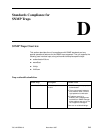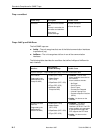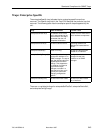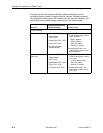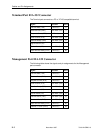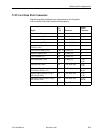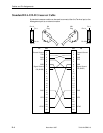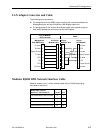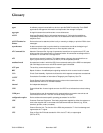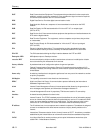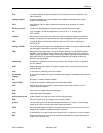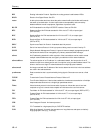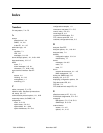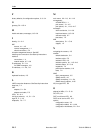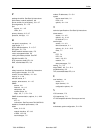
Glossary
GL-4
7610-A2-GB20-10
November 1997
Routing Information Protocol. Specifies the routing protocol used between DSUs.
Receive Line Signal Detect. See CD.
A device that makes decisions about the paths network traffic should take and forwards
that traffic to its destination. A router helps achieve interoperability and connectivity
between different vendor’s equipment, regardless of protocols used.
An EIA standard for the 25-pin DCE/DTE interface. Same as EIA-232.
Request to Send. An EIA-lead standard for V.24 circuit CT 105; an input signal
(DTE-to-DCE).
Received Clock. An EIA-lead standard for V.24 circuit CT 115; an output signal
(DCE-to-DTE).
Received Data. An EIA-lead standard for V.24 circuit CT 104; an output signal
(DCE-to-DTE).
Synchronous Data Link Control. A standard data link protocol.
Serial Line Internet Protocol. A link layer protocol being used over serial lines by IP.
Simple Network Management Protocol. A generic internet network management protocol
that allows the device to be managed by any industry-standard SNMP manager.
An IP addressing standard in which a portion of the host address can be used to create
multiple network addresses that are logically a subdivision of the network address.
The subnet portion of an IP address. In a subnetted network, the host portion of an IP
address is split into a subnet portion and a host portion using a subnet address mask. This
allows a site to use a single IP network address for multiple physical networks.
An integer used with the IP address of the host to determine which bits in the host address
are used in the subnet address.
Data transmission that is synchronized by timing signals. Characters are sent at a fixed
rate.
Transmission Control Protocol/Internet Protocol. Refer to IP.
Time Division Multiplexer. A device that enables the simultaneous transmission of multiple
independent data streams into a single high-speed data stream.
Virtual terminal protocol in the Internet suite of protocols. Allows the user of one host
computer to log into a remote host computer and interact as the user for that host.
Test Mode. An EIA-lead standard for V.24 circuit CT 142; an output signal (DCE-to-DTE).
Transmit Clock. An EIA-lead standard for V.24 circuit CT 114; an output signal
(DCE-to-DTE).
Transmit Data. An EIA-lead standard for V.24 circuit CT 103; an input signal
(DTE-to-DCE).
User Datagram Protocol. An Internet protocol.
ITU-T standard for a high-speed, 34-pin, DCE/DTE interface.
Wide Area Network. A network that operates over long distances and spans a relatively
large geographic area (e.g., a country).
RIP
RLSD
router
RS-232
RTS
RXC
RXD
SDLC
SLIP
SNMP
subnet
subnet address
subnet mask
synchronous
TCP/IP
TDM
Telnet
TM
TXC
TXD
UDP
V.35
WA N



